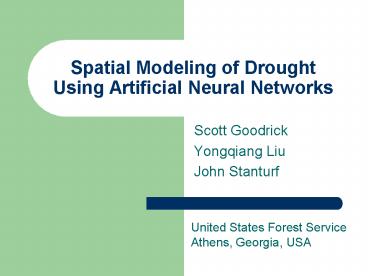Spatial Modeling of Drought Using Artificial Neural Networks PowerPoint PPT Presentation
1 / 25
Title: Spatial Modeling of Drought Using Artificial Neural Networks
1
Spatial Modeling of Drought Using Artificial
Neural Networks
- Scott Goodrick
- Yongqiang Liu
- John Stanturf
United States Forest Service Athens, Georgia, USA
2
Introduction
- Drought is a natural disaster that can have
severe economic consequences across a large area - Spatial extent of drought is vital component in
assessing consequences - Remote sensing good tool but lacks ability to
examine past events
3
Alternative Methods of Spatial Modeling
- Use routine weather observations
- Methodology should account for a wide range of
environmental features that affect variability in
the observations
4
Artificial Neural Networks
- Means of mapping a set of input data to a desired
output - Universal function approximator
- Excellent tool for discovering patterns within
the data
5
Network Diagram
Inputs
Neural Network
Output
6
Data
- Weather observations
- Temperature (Output)
- Location
- Topography
- Elevation
- Slope/Aspect
- Land Cover
- Vegetation Cover
7
Network Diagram
Inputs
Processing
Output
Latitude Longitude Elevation Slope Aspect A
lbedo Water
Temperature
8
Application of ANN
- Data preparation
- Adjusting the Distribution
- Training Set
- Testing Set
- Training Methodology
- Error minimization problem
- Two stage training
- Focus on cases with poor performance
9
Analysis Region
10
Results
- Network Training Performance
11
Max
Mean s
Mean
Mean - s
Min
12
(No Transcript)
13
(No Transcript)
14
(No Transcript)
15
(No Transcript)
16
Results
- Neural Network has learned the input data very
well - How well does it represent data not present in
the training data set.
17
(No Transcript)
18
Results
- Neural Network has learned the input data very
well - How well does it represent data not present in
the training data set. - RMSE for Testing Data 3.11 C
19
Measuring Drought
- Drought can be viewed as two components
- Rainfall Deficit Term
- Drying Term
- Use ANN temperature analysis to calculate drying
term - Contrast 2001 and 2003
20
(No Transcript)
21
2001
22
2003
23
Difference 2003-2001
24
Summary
- Artificial Neural Networks are capable of
producing realistic spatial fields of temperature - Artificial Neural Networks allow us to look at a
spatial representation of historical conditions
from routine weather observations
25
Future Work
- Extend analysis to other weather parameters
- Test at higher spatial resolutions
- Test as a means of downscaling climate model data

